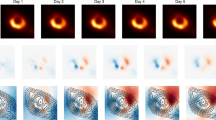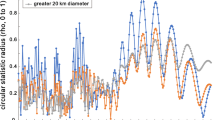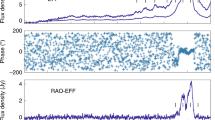Abstract
Images of Saturn's narrow and contorted F ring returned by the Cassini spacecraft1 have revealed phenomena not previously detected in any planetary ring system. The perturbing effect of the inner shepherding satellite, Prometheus, seems to introduce channels through the F ring and a ‘streamer’—a line of particles that link the ring to the satellite. The detailed mechanism for the formation of these features has been lacking an explanation. Here we show that these phenomena can be understood in terms of a simple gravitational interaction as Prometheus approaches and recedes from the F ring every 14.7 hours. Our numerical models show that as Prometheus recedes from its closest approach to the F ring, it draws out ring material; one orbital period later, this affected region has undergone keplerian shear and is visible as a channel, in excellent agreement with structures seen in the Cassini images. Prometheus' periodic disruption of the F ring will become more pronounced as the two orbits approach their minimum separation in 2009. The model predicts that the appearance of streamers and the associated channels will vary in a regular fashion on a timescale of one orbital period.
This is a preview of subscription content, access via your institution
Access options
Subscribe to this journal
Receive 51 print issues and online access
$199.00 per year
only $3.90 per issue
Buy this article
- Purchase on Springer Link
- Instant access to full article PDF
Prices may be subject to local taxes which are calculated during checkout




Similar content being viewed by others
References
Porco, C. C. et al. Cassini imaging science: Initial results on Saturn's rings and small satellites. Science 307, 1226–1236 (2005)
Borderies, N. & Goldreich, P. The variations in eccentricity and apse precession rate of a narrow ring perturbed by a close satellite. Icarus 53, 84–89 (1983)
Kolvoord, R. A., Burns, J. A. & Showalter, M. R. Periodic features in Saturn's F ring. Nature 345, 695–697 (1990)
Murray, C. D. & Giuliatti Winter, S. M. Periodic collisions between the moon Prometheus and Saturn's F ring. Nature 380, 139–141 (1996)
Jacobson, R. A. & French, R. G. Orbits and masses of Saturn's coorbital and F-ring shepherding satellites. Icarus 172, 382–387 (2004)
Bosh, A., Olkin, C. B., French, R. G. & Nicholson, P. D. Saturn's F ring: Kinematics and particle sizes from stellar occultation studies. Icarus 157, 57–75 (2002)
Porco, C. C. et al. Cassini imaging science: Instrument characteristics and anticipated scientific investigations at Saturn. Space Sci. Rev. 115, 363–497 (2004)
Murray, C. D., Gordon, M. K. & Giuliatti Winter, S. M. Unravelling the strands of Saturn's F ring. Icarus 129, 304–316 (1997)
Showalter, M. R. & Burns, J. A. A numerical study of Saturn's F ring. Icarus 52, 526–544 (1982)
Kolvoord, R. A. & Burns, J. A. Three-dimensional perturbations of particles in a narrow planetary ring. Icarus 95, 253–264 (1992)
Giuliatti Winter, S. M. The Dynamics of Saturn's F Ring. PhD thesis, Queen Mary and Westfield College, Univ. London (1994)
Giuliatti Winter, S. M., Murray, C. D. & Gordon, M. K. Perturbations to Saturn's F ring strands at their closest approach to Prometheus. Planet. Space Sci. 48, 817–827 (2000)
Renner, S., Sicardy, B. & French, R. G. Prometheus and Pandora: masses and orbital positions during the Cassini tour. Icarus 174, 230–240 (2005)
Dermott, S. F. in Planetary Rings (eds Greenberg, R. & Brahic, A.) 589–637 (Univ. Arizona Press, Tucson, 1984)
Acknowledgements
C.D.M., K.B., N.C. and M.W.E. are grateful to the UK Particle Physics and Astronomy Research Council for financial support. C.C. thanks the Astronomy Unit, Queen Mary, University of London and the Mexican Council for Science and Technology, CONACYT, for financial support. J.A.B. was supported by the Cassini project and Cornell University. C.C.P. acknowledges support from NASA/JPL and the Cassini project.
Author information
Authors and Affiliations
Corresponding author
Ethics declarations
Competing interests
Reprints and permissions information is available at npg.nature.com/reprintsandpermissions. The authors declare no competing financial interests.
Rights and permissions
About this article
Cite this article
Murray, C., Chavez, C., Beurle, K. et al. How Prometheus creates structure in Saturn's F ring. Nature 437, 1326–1329 (2005). https://doi.org/10.1038/nature04212
Received:
Accepted:
Issue Date:
DOI: https://doi.org/10.1038/nature04212
This article is cited by
-
Ring detected around a dwarf planet
Nature (2017)
-
Prometheus Induced Vorticity in Saturn’s F Ring
Earth, Moon, and Planets (2016)
-
Gravitational Vortices And Clump Formation In Saturn's F ring During An Encounter With Prometheus
Scientific Reports (2013)
-
Proposed exoplanets may be just gas and dust
Nature (2013)
-
The determination of the structure of Saturn’s F ring by nearby moonlets
Nature (2008)
Comments
By submitting a comment you agree to abide by our Terms and Community Guidelines. If you find something abusive or that does not comply with our terms or guidelines please flag it as inappropriate.



